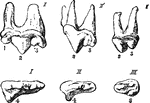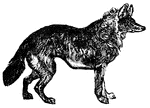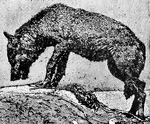Clipart tagged: ‘Canis’

Intestinal Tract from Canis Vulpes
Intestinal tract of Canis vulpes. S, cut end of duodenum; C, caecum; R, cut end of rectum.

Carnivora
"Upper Sectorial Teeth of Carnivora. I, Felis; II, Canis; III, Ursus, 1, anterior, 2, middle, and 3,…

Jackal
Similar to the fox in appearance, but without the bushy tail. They are found in Africa and S. Asia.…

Jackal
Similar to the fox in appearance, but without the bushy tail. The are found in Aftrica and S. Asia.…

Wolf
The wolf belongs to the dog family. There are three recognized species of wolf and they are generally…

Wolf
"Wolf is the vernacular name of certain species of the genus Canis. The common wolf (C. lupus) has very…

